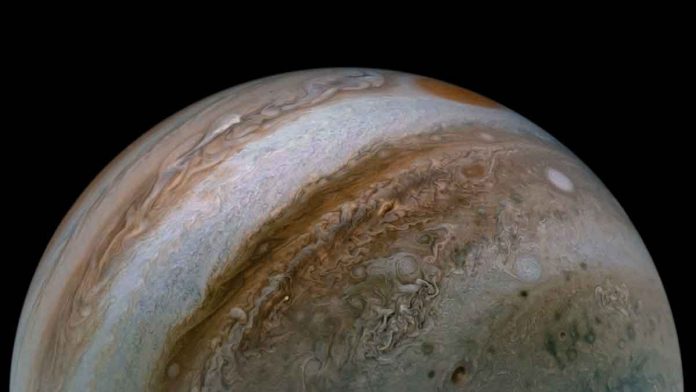The gaseous envelope of Jupiter does not have a uniform distribution, according to an international team of astronomers lead by Yamila Miguel (SRON/Leiden Observatory). The interior sections of Jupiter have more metals than the outer parts, amounting to between 11 and 30 earth masses, or 3–9% of Jupiter’s total mass. This metallicity is high enough to suggest that kilometer-sized bodies, or planetesimals, must have had a role in Jupiter’s formation. It will be published in Astronomy & Astrophysics on June 8th.
When NASA’s Juno spacecraft arrived at Jupiter in 2016, we were treated to a stunning view of our solar system’s largest planet. Jupiter, in addition to the iconic Great Red Spot, is riddled by hurricanes, giving it the appearance and mystique of a Van Gogh painting. However, the planet’s envelope behind the thin visible layer is not immediately discernible. Even so, Juno is able to create a picture for us by feeling the gravitational force above several Jupiter places. This provides astronomers with information on the internal composition, which differs from what we perceive on the surface.
The gaseous envelope is not as homogeneous and well-mixed as previously thought, according to an international team of astronomers lead by Yamila Miguel (SRON/Leiden Observatory). Instead, metals—elements heavier than hydrogen and helium—have a larger contraction toward the planet’s centre. The scientists used a multitude of theoretical models that adhered to the observational limits measured by Juno to arrive at their conclusions.
The scientists looked at the distribution of metals since it reveals details about Jupiter’s genesis. The metals are not evenly distributed throughout the envelope, with more in the interior than in the exterior. The entire number of metals is estimated to be between 11 and 30 Earth masses. “A gas giant like Jupiter can acquire metals in two ways during its formation: through the accretion of small pebbles or larger planetesimals,” Miguel explains. We know that once a new born planet reaches a certain size, it begins to eject stones. The current level of metal richness inside Jupiter was previously unattainable. As a result, we can rule out a scenario in which Jupiter formed entirely of pebbles. Planetesimals are too large to be blocked, thus they have to be involved.”
The fact that the inner half of the envelope has more heavy elements than the outer part indicates that the abundance declines in a gradient rather than being uniform across the envelope. “We used to think Jupiter had convection, like boiling water, which made it fully mixed,” Miguel explains. “However, our findings demonstrate otherwise.”

